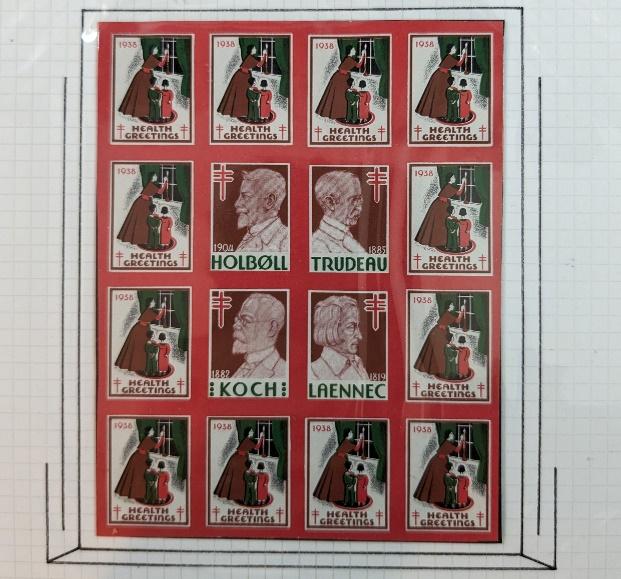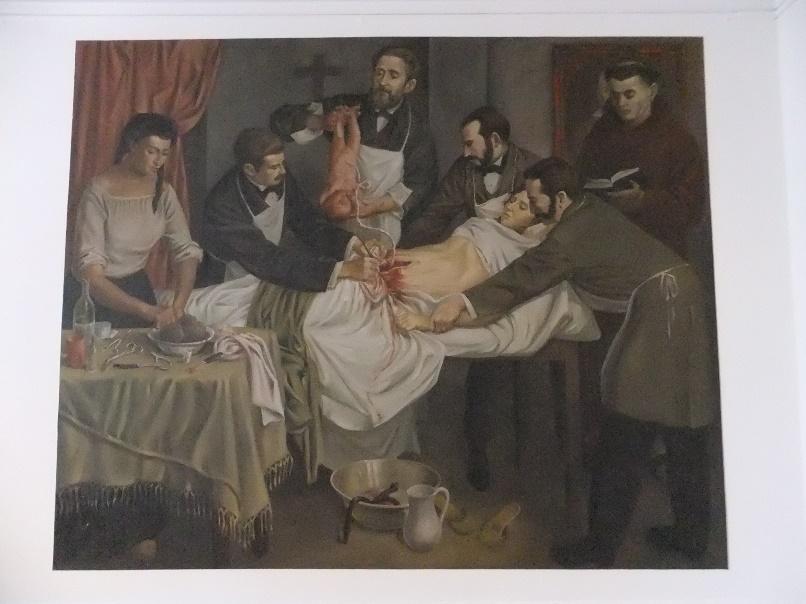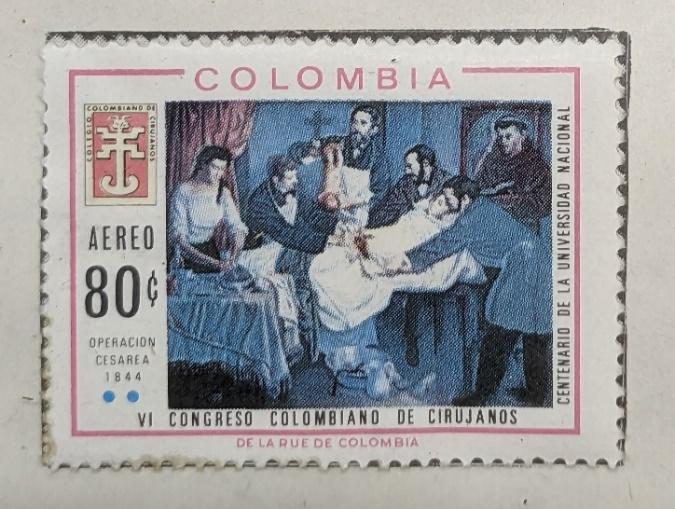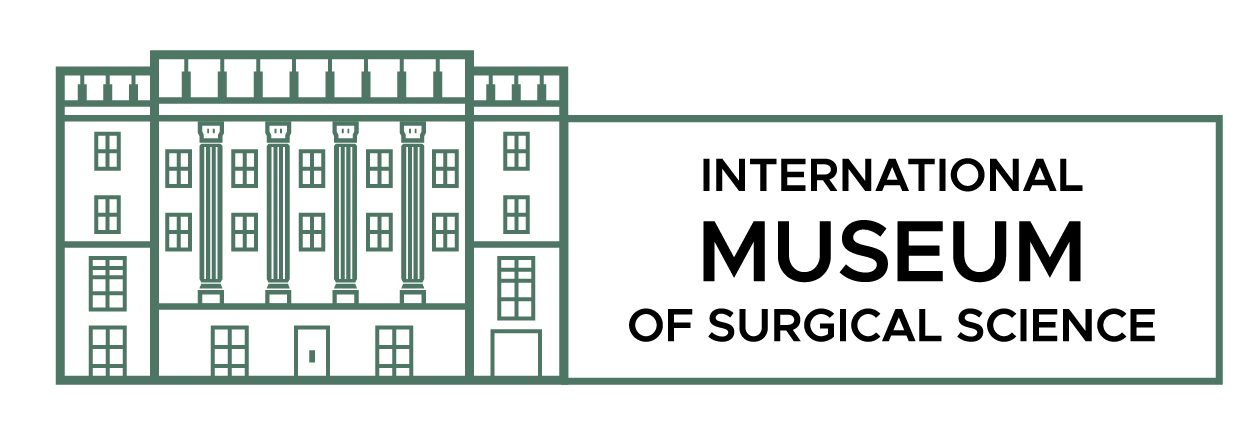Published by Julia Rossi
Shortly after I began my internship with the International Museum of Surgical Science, I asked Michelle Rinard, the Curator at the IMSS, if I could take a look at the Museum’s collection catalog. I spent hours sifting through thousands of fascinating object records. There were entries for bloodletting basins and surgical kits, early X-ray devices and prints, medical illustrations and advertisements, paintings and sculptures featuring people and events from medical history, and more. The IMSS’s collection is rich and varied, teeming with objects that offer touchstones into the long history of medicine.
Among the many thousands of objects in the IMSS’s collection are hundreds of medically-themed postage stamps, issued and circulated by countries around the globe. The sheer number of postage stamps in the Museum’s collection sparked my curiosity. I began to wonder: What can we learn about the history of medicine by turning to the history of postage? How have countries around the world used postage to direct public attention to medical matters? What social, political, and artistic patterns can we identify by looking at a broad range of medical postage stamps? Eager to explore these questions in more depth, I arranged for a research appointment with Michelle, and spent an afternoon poring over hundreds of stamps.
***********
Most of the medically-themed postage stamps in the International Museum of Surgical Science’s collection come from a single donor: a doctor named Joseph H. Kler (1903-1983). A New York Times obituary for Dr. Kler notes that he was born in Chicago, though he spent much of his career in New Jersey, where he established the first infirmary at Rutgers University in 1931. The obituary recalls Dr. Kler as an avid collector and an advocate for architectural preservation.
Dr. Kler died almost a decade before I was born. Still, after spending an afternoon sifting through his collection of postage stamps, I feel tempted to venture a few hypotheses about his personality – namely, that he was a remarkably thorough and precise person. Each stamp in the collection has been carefully mounted onto a sheet of thick graph paper; Dr. Kler has drawn thick, straight lines around each mounted stamp or set of stamps, ensuring that they are framed squarely within the page. Consider the example below, which shows Dr. Kler’s neatly outlined and captioned copy of a 1971 British commemorative stamp featuring the poet John Keats (1795-1821). (How did Keats make his way into a collection of medical postage stamps?, you might ask. Dr. Kler’s caption supplies an answer: before he decided to devote his career to poetry, Keats completed an apprenticeship in the office of an apothecary and surgeon).

As I began combing through Dr. Kler’s collection, I assumed that the text surrounding each stamp – which included headings and subheadings, as well as captions that identify the relevance of each stamp to medical history – were typewritten. The clear, italicized print was simply too perfect for me to imagine that it had been produced by hand. Still, I was puzzled: I had been under the impression that typewriters – which would have been the typing machine of Dr. Kler’s day – did not include settings for italicized print. In search of a second opinion, I showed a particularly interesting page to my fellow intern, Maeve, who suggested that the pages were actually handwritten. I re-examined the pages closely and began to notice ever-so-slight variations in the way the same letter appeared in various instances on a page. Maeve was right: Dr. Kler wrote out the pages of his medical postage stamp collection with an almost unbelievably clean and precise hand.
The stamps themselves, so beautifully arranged, mounted, and captioned by Dr. Kler, are tiny, perforated windows into history. They can be loosely divided into two categories: 1.) stamps that commemorate an individual or event of some significance to the history of medicine; and 2.) stamps that were intended to raise awareness or funds for public health causes.
A typical example of a stamp produced to memorialize an individual who contributed to the history of medicine can be found below. This stamp, issued in France in 1936, depicts a familiar face for visitors of the International Museum of Surgical Science: Louis Pasteur (1822-1895). Pasteur is perhaps known for his role in inaugurating the concept of “germ theory” (that is, the notion that diseases are caused by microorganisms that invade their hosts and reproduce). His work on microorganisms also led him to develop a technique for food preservation that we still use today, and that bears his name: pasteurization. This French stamp, issued roughly 40 years after Pasteur’s death, shows Pasteur gazing intently at a test tube.

Pasteur’s legacy remains unambiguously celebrated in France and around the world – but several of the postage stamps in Dr. Kler’s collection point to darker, violent histories. Consider, for example, the stamp seen below. It depicts a portrait of Noel Eugene Ballay (1848-1902), a French surgeon who helped to establish French colonial occupation of territories in West Africa. Ballay represented France in the infamous Berlin Conference of 1881, during which European leaders negotiated “regulations” amongst themselves to facilitate their invasion and conquest of the African continent. Alongside a portrait of Balley, which is encircled in the words “Afrique Occidentale Francaise / Postes” (“French West Africa / Mail”), the stamp includes a much less detailed rendering of a West African woman, unclothed above her waist. In this tiny portrait, barely an inch in length, we can clearly see the mechanics of racial and national power at play. Ballay is treated as an individual, his face carefully rendered to align closely with photographs taken during his later life, while the woman stands as an unnamed and deindividualized representative of colonized West Africa.

Ballay is far from the only physician-turned-colonial-administrator to appear on a postage stamp. For example, one stamp in Dr. Kler’s collection depicts Leander Starr Jameson (1853-1917), a physician who worked with Cecil Rhodes to expand the colonial reach of the British South Africa Company. Yet another features Jan van Riebeeck (1619-1677), a Dutch naval surgeon who went on to establish the first permanent European settlement in South Africa.
The prevalence of stamps that memorialize figures like these – physicians and surgeons who worked to further the interests of colonizing powers – raises profound questions about who gets memorialized, when, and by whom. It also starkly reveals the ways in which the history of medicine is braided into the history of global power and colonial domination. It would be tempting to use the long tradition of medical postage stamps to tell a sanitized version of the history of medicine – a story about good doctors who always treated people well, whose research and practice never wavered from a respect for all of humanity. The full story is less easy and more violent.
***********
Another sub-category of medically-themed postage stamp consists of stamps that were circulated to raise awareness or funds for public health campaigns. Dr. Kler’s collection offers fascinating visibility into this aspect of postage history. The collection includes a set of stamps (pictured below), issued in Belgium in 1955, that commemorate Einar Holbøll (1865-1927). Holbøll was a Danish postal worker who came up with the idea of producing specialized postage “seals” around the Christmas holidays to raise money for charitable causes. “Christmas seals” differ from stamps in that they are not considered valid forms of postal payment, even though they look and function very much like postage stamps; instead, they are voluntarily purchased and affixed to Christmas postcards as a gesture of charitable spirit. The first of Holbøll’s “Christmas seals” were printed in December 1904 and were dedicated to raising funds for a children’s tuberculosis sanatorium. This concept was quickly taken up in other countries, including the United States, and the association between Christmas seals and anti-tuberculosis campaigns persisted throughout the twentieth century. See below for an example – a set of U.S. Christmas seals, issued by the U.S. National Tuberculosis Association in 1938. One corner of each cluster of four stamps memorializes a public figure who contributed to the fight against tuberculosis. Holbøll himself appears in one stamp, as do Edward Livingstone Trudeau (a public health leader who established a sanatorium and a laboratory for the treatment and study of tuberculosis); Rene Theophile Hyacinthe Laënnec (a French physician who developed the first stethoscope, a pivotal tool for diagnosing tuberculosis); and Heinrich Hermann Robert Koch (a German physician and microbiologist who identified bacteria as the causal agents of tuberculosis).


U.S. “Christmas Seals” (issued 1938), sold to raise funds for the U.S. National Tuberculosis Association
At various moments in countries across the world, actual postage stamps – as opposed to Christmas seals – have been printed with the express purpose of raising funds for a public health campaign. Consider the example below, which was produced as part of an anti-malaria campaign in Mexico in 1939. In 1938, the Mexican government announced that it would mount a national campaign to eradicate malaria. However, the costs of such a project quickly exceeded its allocated budget. To combat this problem, the government circulated this postage stamp, the proceeds of which were earmarked to bolster the eradication campaign. The stamp, printed in Prussian blue, depicts a giant mosquito encircling a man who has fallen to his knees, his arms splayed wide. It is a dramatic image, reminiscent of a scene from a horror film, and it vividly captures the sense of helplessness and dread that so powerfully accompanies the outbreak of disease.

***********
One postage stamp – the only one in the Museum’s collection that did not come from Dr. Kler – is particularly well-known among the staff at the International Museum of Surgical Science. Issued by the government of Colombia in 1967, the stamp contains a miniaturized version of a mural that hangs on the third floor of the Museum. The mural was created by Enrique Grau, a celebrated Colombian artist. Grau’s painting depicts the scene of the first successful C-section in South America (that is, the first such procedure in which both mother and child survived). I have often paused to contextualize this mural while delivering tours of the Museum, drawing visitors’ attention to various haunting aspects of the scene. On the left-hand side of the painting, a nurse dips her hands into a bowl that contains several sponges. Those sponges would have been soaked in the juice of mandrake root, a hallucinogenic plant that has been used to mitigate pain in cultures around the world for thousands of years. The nurse – possibly a close friend or family member of the woman in labor – would have attended to the patient’s pain throughout the procedure, squeezing drops of mandrake juice into her mouth. The patient’s senses would have been dulled, but she would still have been conscious, and still in pain; in Grau’s painting, two men stand on either side of the woman, holding her arms down at her sides as she clutches her bedsheets tightly. Perhaps even more perturbing is the shadowy figure who stands behind the woman’s bed, his eyes trained on the text of a book: a priest – come to deliver last rites. The Colombian College of Surgeons selected this scene for printing on a postage stamp to celebrate a landmark moment in Colombia’s medical history, but the painting also serves as a chilling reminder of the countless lives that have been cut short during childbirth throughout human history. 
Enrique Grau, “First Cesarean Section.” International Museum of Surgical Science Collection.
Grau’s painting looms large in the Museum’s exhibition room dedicated to the history of obstetrics, spanning nearly the full length of a wall. Having grown accustomed to the sheer size of Grau’s work, I was fascinated to encounter its reproduction in the drastically compressed scale of a postage stamp. In this form, the details of the scene are difficult to parse; the bowl of mandrake juice, for example, is reduced to a barely distinguishable blur. Still, the fragile and faded stamp vividly conveys the poignancy of the scene. We are left with an overpowering sense of the urgency and bustle of the surgical procedure itself; the tiny stamp is crowded with no less than eight people. As is the case when I look at Grau’s mural, my eyes are drawn to the pained face and open abdomen of the laboring woman in the postage stamp. For a moment, I don’t even notice an essential detail – that a surgeon holds the newborn baby upside down by the ankle. 
.Colombian postage stamp (issued 1967) containing a miniaturized reproduction of Enrique Grau’s mural.
Next to Grau’s painting, the upper-left-hand side of the postage stamp includes the symbol of the Colombian College of Surgeons. According to article clippings from the Museum’s collection that discuss the context of this postage stamp, this symbol was derived from an ancient surgical instrument that has been found in artifacts from the Quimbayas tribe (dating to around 1400 B.C.). It is a fitting reminder of the sheer temporal scope of humanity’s efforts to intervene in outcomes of the body.
***********
The postage stamps in the IMSS’s collection distill sweeping stories: stories of governments combatting disease, of the unsettling connections between medical practice and colonial domination, of breakthroughs in medical understanding, and of the countless people whose efforts have combined to give us vaccines, surgical techniques, sanitation, and more. And, at the same time, stamps are also vehicles for deeply personal stories. They are ephemeral creations, intended to be fixed onto the corners of envelopes – envelopes that contain love letters, employment contracts, precious photographs, tax documents, and the many other kinds of paper that make up our everyday lives. Perhaps it was this collision between the global and the personal, the grand and the miniature, that motivated Dr. Kler to develop his collection with such care.
Bibliography
Cueto, Marcos. Cold War, Deadly Fevers: Malaria Eradication in Mexico, 1955-1975. Woodrow Wilson Center Press: Johns Hopkins University Press, 2007.
Gangstad, Erin Nicole. “Making Present, Making Absent: Exploring Medical Fundraising Imagery Through the National Tuberculosis Association Christmas Seals.” Rhetoric of Health & Medicine Vol. 4, No. 3 (Summer 2021).
“Joseph H. Kler, 80, Physician and Preservationist in Jersey.” Obituary. The New York Times, 25 November 1983.
Julia Rossi was the summer 2023 Education Intern, and is a PhD Candidate in English Literature at the University of Chicago. She studies nineteenth-century British literature and culture, with specializations in economic history and urban studies. She is also interested in using museum collections to tell stories about the past and its relationship to the present.
Purchase Ticket Admission


